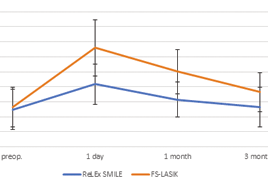Purpose: To compare the influence of the LASIK and ReLEx SMILE refractive method on tear osmolarity
Methods: Prospective non-randomized comparative study. We evaluated the results in two groups of patients who underwent binocular refractive surgery to remove myopia and possibly astigmatism in the eye clinic of Horní Počernice. In each group were 15 patients (30 eyes), patients of one group undergoing FS-LASIK refractive surgery, in the second group a ReLEx SMILE procedure. Bilateral measurement of the tear film osmolarity using the TearLab instrument on the day of surgery, the first day after surgery, one month and 3 months after surgery was performed on each patient.
Results: The mean preoperative value of the osmolarity of the tear film was practically the same in both groups, in the ReLEx SMILE group 294.9 ± 13.4 mOsm/l and in the FS-LASIK group 296.4 ± 13.1. One and three months after the surgery in the ReLEx SMILE group, these values increased to 301.4 and 296.4 ± 13.3 mOsm/l respectively, the elevation of values one month after surgery was statistically significant. In the FS-LASIK group, one month after surgery, the osmolarity was 320.1 ± 14.7, three months postoperatively 306.5 ± 13.1 mOsm / l. Both of these values compared to the preoperative value were statistically significantly higher. The increase of the mean osmolarity was statistically significantly higher in the FS-LASIK group compared to the ReLEx SMILE. Three months after surgery, the difference between groups was not statistically significant.
Conclusion: In our group of patients, after the FS-LASIK refraction procedure, we noted a higher mean osmolarity of tear film in comparison with patients after the ReLEx SMILE in all evaluated timepoints (1 day, 1 month and 3 months after surgery). We consider ReLEx SMILE as a method with less impact on the quality of tear film, with a faster return to original osmolarity and potentially higher patient comfort.

